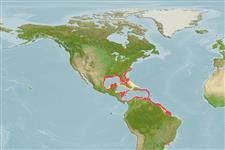>
Ophidiiformes (Cusk eels) >
Ophidiidae (Cusk-eels) > Ophidiinae
Etymology: Lepophidium: Latin, lepus, leporis = rabbit + Greek, ophis = serpent (Ref. 45335).
More on author: Cuvier.
Environment: milieu / climate zone / depth range / distribution range
Ekologi
laut dasar (demersal); kisaran kedalaman 5 - 115 m (Ref. 91765). Tropical; 36°N - 26°S, 98°W - 43°W (Ref. 91765)
Western Atlantic: widespread along the Atlantic coast of the United States (from North Carolina), through the Gulf of Mexico and the Caribbean, to the coasts of South America (up to Uruguay); apparently absent in the Bahamas.
Size / Weight / umur
Maturity: Lm ? range ? - ? cm
Max length : 28.8 cm SL jantan/; (Ref. 128822); common length : 20.0 cm TL jantan/; (Ref. 5217)
deskripsi pendek
Morfologi | Morfometrik
Duri punggung (Keseluruhan (total)): 0; duri punggung lunak (Keseluruhan (total)): 120-134; Duri dubur 0; Sirip dubur lunak: 99 - 110; vertebrata, bertulang belakang: 69 - 74. Rostral spine long and curved, reaching tip of snout, without vertical basal component; peritoneum pale; no median basibranchial tooth patch; head extensively covered with imbricate rows of cycloid scales except for snout and throat; body tapering to point, dagger-shaped (Ref. 34024). Body dark gray or brownish gray without blotches; dorsal and anal fins dark, becoming gradually darker at the extreme blackish edge; pelvic fin blackish in anterior half and pale in posterior half; gill arch blackish or brownish; head covered with scales except for snout, lips, and branchiostegal membrane (Ref. 13608).
Common species (Ref. 34024). Found on soft bottom (Ref. 7251). Oviparous, with oval pelagic eggs floating in a gelatinous mass (Ref. 205).
Robins, C.R., R.H. Robins and M.E. Brown, 2012. A revision of Lepophidium (Teleoastei, Ophidiidae), with descriptions of eight new species. Bulletin of the Florida Museum of Natural History 52(1):1-94. (Ref. 91765)
Status IUCN Red List (Ref. 130435)
ancaman kepada manusia
Harmless
penggunaan manusia
Perikanan: nilai komersial kecil
informasi lanjut
AcuanBudidaya airprofil budidaya airStrainGenetikaElectrophoresesDiturunkanPenyakit-penyakitPengolahanNutrientsMass conversion
mitraGambarStamps, Coins Misc.Suara-suaraCiguateraKecepatanTipe renangArea insangOtolithsOtakPenglihatan / visi
Alat, peralatan
laporan khas
muat turun XML
Sumber internet
Estimates based on models
Preferred temperature (Ref.
123201): 21.8 - 27.8, mean 26 °C (based on 464 cells).
Phylogenetic diversity index (Ref.
82804): PD
50 = 0.5000 [Uniqueness, from 0.5 = low to 2.0 = high].
Bayesian length-weight: a=0.00269 (0.00156 - 0.00465), b=3.11 (2.96 - 3.26), in cm total length, based on LWR estimates for this species & Genus-body shape (Ref.
93245).
Trophic level (Ref.
69278): 3.6 ±0.7 se; based on size and trophs of closest relatives
Daya lenting (Ref.
120179): sedang, Waktu penggandaan populasi minimum 1.4 - 4.4 tahun (Preliminary K or Fecundity.).
Fishing Vulnerability (Ref.
59153): Low to moderate vulnerability (25 of 100).
Nutrients (Ref.
124155): Calcium = 188 [106, 364] mg/100g; Iron = 1.34 [0.81, 2.20] mg/100g; Protein = 16 [13, 18] %; Omega3 = 0.196 [0.102, 0.359] g/100g; Selenium = 62.4 [30.3, 133.6] μg/100g; VitaminA = 36.3 [12.5, 104.3] μg/100g; Zinc = 1.2 [0.9, 1.7] mg/100g (wet weight);
